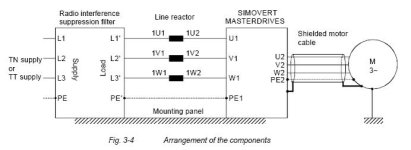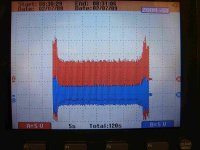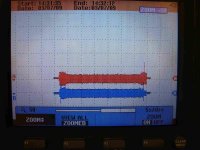mattwaterhouse
Member
Just wondering if anyone has any experience with this issue
As part of a large installation we have a machine with 4 x 120HP 3PH motors each controlled by a SIEMENS SIMOVERT MC/P2 170A VF Drive.
These motors all seem to function correctly but we have been having issues with false prox switch inputs on the drives and PLCs for this machine.
I connected a scope to the signal return line from a prox out on the machine. Without the drives running the signal is dead flat, the moment the drives start there is all kinds of noise and interference on the signal, some times exceeding 30V (it as 24VDC prox)
This doesn't seem normal or acceptable does it?
The motor cables are all shielded and bonded to ground at the drive end. The signal cable to/from the prox is just normal un-sheilded wire.
As a second test I just lay a 30m length of 1mm wire across the floor near the machine and scoped that (relative to earth) and I see the same noise there too..... the other end connected to nothing!
Any help / thoughts on this subject would be much appreciated.
As part of a large installation we have a machine with 4 x 120HP 3PH motors each controlled by a SIEMENS SIMOVERT MC/P2 170A VF Drive.
These motors all seem to function correctly but we have been having issues with false prox switch inputs on the drives and PLCs for this machine.
I connected a scope to the signal return line from a prox out on the machine. Without the drives running the signal is dead flat, the moment the drives start there is all kinds of noise and interference on the signal, some times exceeding 30V (it as 24VDC prox)
This doesn't seem normal or acceptable does it?
The motor cables are all shielded and bonded to ground at the drive end. The signal cable to/from the prox is just normal un-sheilded wire.
As a second test I just lay a 30m length of 1mm wire across the floor near the machine and scoped that (relative to earth) and I see the same noise there too..... the other end connected to nothing!
Any help / thoughts on this subject would be much appreciated.









